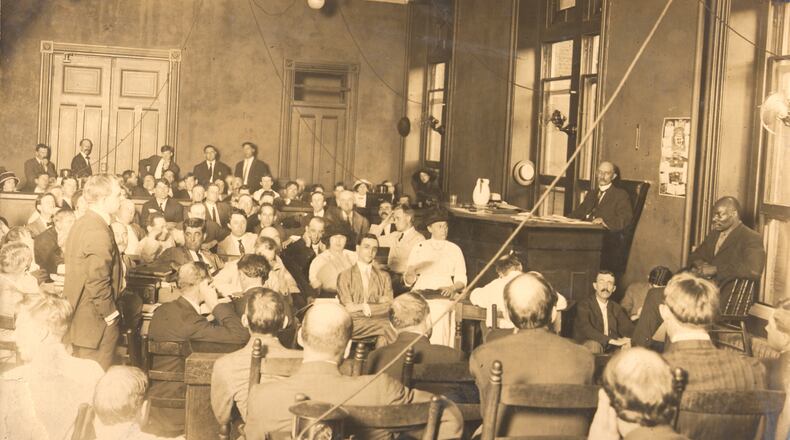When Senate Majority Leader Chuck Schumer gave his speech about the rise of antisemitism in the United States on the floor of the Senate recently, he said that “after Oct. 7, American Jews are feeling singled out, targeted and isolated — in many ways, we feel alone.”
Jews in Georgia have experienced those same feelings when antisemitism has reared its ugly head here. But there have been shining moments of reconciliation as well. Two incidents some 40 years apart make the point:
Fear gripped the Atlanta Jewish community in April of 1913, when Leo Frank, a Jewish businessman from New York was arrested by Atlanta police in the murder of 13-year-old Mary Phagan, a Marietta girl who worked at the Atlanta pencil factory where Frank served as superintendent.
Frank’s trial unleashed a wave of antisemitic rage. Crowds gathered outside the Fulton County Courthouse to cheer on prosecutor Hugh Dorsey — who later was elected governor — as he arrived for court each day. According to news reports, the crowds celebrated wildly when news of the conviction reached the street.
The frenzy of antisemitic hatred peaked after Gov. John Slaton, citing what he called insufficient evidence of Frank’s guilt, commuted his sentence from death to life imprisonment. On the night of Aug. 16, 1915, a group of men calling themselves “The knights of Mary Phagan” kidnapped Frank from his cell at the state prison farm in Milledgeville, drove him to Phagan’s hometown of Marietta, and hanged him from an oak tree.
Following Frank’s death, many Atlanta Jews felt the isolation, loneliness and fear that Schumer spoke of.
The New York Times reported that as many as 3,000 Jews fled Atlanta after the lynching. Steve Oney, author of “And the Dead Shall Rise,” which is considered the most exhaustively researched book on the Frank case, told ArtsATL he believed that number may be inflated, but he called the Frank lynching “a blunt-force trauma to the Jewish community (with most) living in fear and confusion.”
Adding to the fear was the fact that the lynching revived the Ku Klux Klan in Georgia after it had been moribund for decades.
Forty-three years after Leo Frank’s death, on Oct. 12, 1958, another violent antisemitic event shook the Atlanta Jewish community. On that day a white supremacist group detonated a bomb at The Temple, an iconic Atlanta home for Jewish worshippers. No one was killed or injured, but the bomb caused major damage to the Peachtree Street synagogue.
This time, though, many non-Jews rallied in support of the Jewish community. Atlanta Mayor William Hartsfield filmed a statement for TV news as he pointed to the wreckage caused by the bomb:
“My friends, here you see the end result of bigotry and intolerance …”
And Atlanta Constitution Editor Ralph McGill wrote “When the wolves of hate are loosed on one people, then no one is safe.”
Rabbi Alvin Sugarman, who grew up at The Temple and later became its long-serving chief rabbi, told me that its assembly room was renamed “Friendship Hall” to honor the support The Temple received from all parts of Atlanta in the wake of the bombing.
But antisemitism isn’t a thing of the past in Georgia, and in fact, there are signs that it’s growing.
Just weeks ago, a white supremacist hate group calling itself the Goyim Defense League projected a laser image praising Adolf Hitler onto an overpass on I-75 in Cobb County. That same group has been responsible for other displays of hatred in metro Atlanta, tossing leaflets with vile antisemitic messages into suburban yards and staging a protest last summer waving Nazi flags in front of a Cobb County synagogue.
And since the war between Israel and Hamas began, Hillel of Georgia has called on the state’s universities to step up security as pro-Palestinian demonstrations have sparked fear among Jewish students at Emory, the University of Georgia and Georgia Tech. Anti-Muslim activities have increased, too, according to the Council on American-Islamic Relations.
By coincidence, I talked with Rabbi Sugarman on the first day of Hanukkah, which is known as the Festival of Lights because it celebrates a time more than 2,000 years ago when the Jewish people fought out of the darkness of occupation by an invading army in Jerusalem into the light of freedom.
Rabbi Sugarman told me that Hanukkah kindles his spirit of eternal optimism. Skeptics might call his hope misplaced, but Sugarman said he believes that people of goodwill will come together as they did in the days after the Temple bombing to fight the darkness of antisemitism and bring light to the lives of the Jewish people.
As the old Jewish saying goes, Rabbi Sugarman, “from your lips to God’s ear.”







